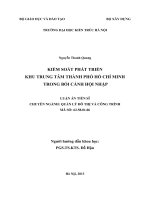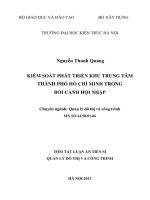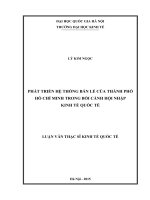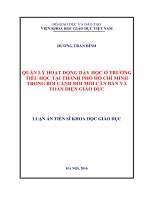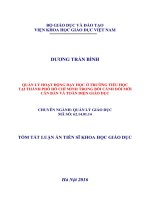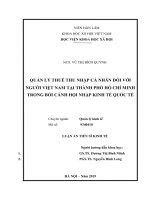Quản lý thuế thu nhập cá nhân đối với người việt nam tại thành phố hồ chí minh trong bối cảnh hội nhập kinh tế quốc tế tt tiếng anh
Bạn đang xem bản rút gọn của tài liệu. Xem và tải ngay bản đầy đủ của tài liệu tại đây (203.92 KB, 26 trang )
ACADEMY VIETNAM SOCIAL SCIENCE
ACADEMY OF SOCIAL SCIENCES
NCS. VU THI BICH QUỲNH
MANAGEMENT OF PERSONAL INCOME TAX FOR VIETNAMESE
PEOPLE IN HO CHI MINH CITY IN CONTEXT OF INTERNATIONAL
ECONOMIC INTEGRATION
Major: Economic management
Code: 9340410
ADVANCED THESIS
Supervisors:
1. Prof.Dr. Duong Thi Binh Minh
2. Assoc. Nguyen Dinh Long
HANOI – 2019
This thesis has been done in: ......................................................................
.....................................................................................................................
Supervisors:
1. Prof. Dr. Dương Thị Bình Minh
2. AProf. Dr. Nguyễn Đình Long
Reviewer 1: AProf. Dr. Vũ Sỹ Cường
Reviewer 2: AProf. Dr. Trương Quốc Cường
Reviewer 3: AProf. Dr. Cao Thị Ý Nhi
This thesis will be defend ...........................................................................
.....................................................................................................................
at ..............., day ......... month .......... year .......
This work can be found at: .........................................................................
.....................................................................................................................
INTRODUCTION
1. The reason for choosing the topic interest
Tax administration is a form of social management since the State
and attached to State power. Tax administration is the process of
impact of tax administration agencies on taxpayers (NNT) to ensure
compliance with tax laws. The impact process of tax administration
agencies to ensure compliance with the law of taxpayers is the process
of implementing tax administration functions such as tax propagation,
supporting taxpayers, managing tax declaration and accounting. tax,
tax inspection, tax inspection, urging tax collection and management,
tax debt enforcement. The management process of tax administration
agencies to taxpayers to influence and adjust the compliance behavior
of taxpayers in accordance with the tax management objectives.
2. Objectives and research tasks of the thesis
2.1. Objectives of the study
Research and generalize the management methods of tax
authorities for taxpayers, analyze the models of personal income tax
management for taxpayers according to qualitative and quantitative
methods, based on which export and apply the compliance model in
personal income tax management in Ho Chi Minh City. HCM in the
context of international integration.
2.2. Research tasks
- Research the theoretical basis of personal income tax
management in which focus on clarifying the model of personal
income tax management according to the theory of common
psychological behavior and theory of compliance behavior.
- Qualitative analysis of PIT management model for Vietnamese
people in Ho Chi Minh City in the context of international economic
1
integration, assessment of achievements, limitations and causes for
tissue innovation orientation tax administration picture.
- Develop and verify the quantitative research model on personal
income tax management according to the compliance model to
provide policy implications and recommendations on personal income
tax management according to the compliance model of taxpayers in
the context of integration international economy.
2.3. Research question
- Does the perception of corruption have an impact on the types of
standards of tax payers (compulsory standards, standards of
description, subjective standards, personal standards)?
3. Subjects and scope of research
3.1. Research subjects
The object of research is managing personal income tax (according
to the popular behavioral behavior model and model of compliance
behavior).
3.2. Research scope
- Space scope: in Ho Chi Minh City.
- Time range: practical situation in the period of 2010-2018 and
recommendations in the vision 2025.
- Scope of survey: resident individuals have income subject to
personal income tax, which is mainly Vietnamese in HCMC. HCM.
4. Methodology and research methods
4.1. Research process
Research interest Literature review Quantitative & qualitative
method to examine personal income tax administration New
knowledge about the solution for tax administration.
4.2. Qualitative method
2
On the basis of summarizing the theory of personal income tax
management, the models of personal income tax management in the
world, thereby finding appropriate models of personal income tax
management in Vietnam. Preliminary qualitative research is
conducted by in-depth interviews of people of working age and
taxable income arises (business individuals, tax teachers, tax
officials). Next is the method of synthesis, analysis, statistics,
description, analysis of typical management situations to assess the
status of personal income tax management in the city. Ho Chi Minh
City, thereby giving a general assessment of the status of personal
income tax management in Ho Chi Minh City. HCM in the context of
international economic integration.
4.3. Quantitative method
Through survey methods to collect data and verify theoretical
models proposed by the dissertation. Specifically: The dissertation
summarizes the theory of managing personal income tax compliance
behavior of NNT, thus proposing research model (model to be
verified), developing research design (including: research process,
scale, preliminary assessment of scales, formal research) and analysis
of survey results (measurement scale by measurement model - confirm
factory analysis (CFA), verification of theoretical and hypothetical
models by Structural equation modeling (SEM).
4.3.1. Sample of quantitative research
Preliminary qualitative research is conducted by in-depth
interviews of people of working age and taxable income arising
(business individuals, tax faculty, tax officials). Based on preliminary
research, we designed a questionnaire consisting of 31 questions with
7 levels of assessment.
3
4.3.2. Quantitative research scale
Wed uses Likert scale in this thesis. Likert scale is a scale in which
"a series of statements related to attitude in question is raised and the
respondent chooses one of those answers" [49, p. 246]. Likert scale is
often used to measure a set of statements of a concept. This is the most
common scale for measuring research concepts in the field of
economic management [49].
4.3.3. Scale test with CFA
PhD student tested the proposed model by CFA assertion factor
analysis method via AMOS linear structure analysis software. The
reason for choosing this method is: CFA method in analyzing linear
structure model has many advantages that allow PhD student to test
the theoretical structure of measurement scales such as the relationship
between a research concept with other concepts that are not biased due
to measurement errors [127].
4.3.4. Testing theoretical models and hypotheses by SEM
structure model
The thesis uses SEM structure model to allow PhD students to
carry out tasks such as testing hypotheses about causality in
accordance with experimental data; verification confirms relations
between variables; verify relationships between observed and
unobserved variables (latent variables).
4.4. Research data
- Secondary data on qualitative research: reports summarizing the
collection of personal income tax, goals and directions over the years
from 2010-2018 period of the Ho Chi Minh City Tax Department;
reports summarizing the establishment of the Ministry of Finance's
Law on Tax Administration in the period of 2010-2018; The research
4
results from the doctoral thesis of universities on the topic of PIT are
closely related to the thesis of the PhD student.
5. New contributions of the thesis
The relationship between personal income tax management and
compliance of taxpayers has been detailed in many studies. The new
point of the thesis is to consider new factors affecting the compliance
behavior of taxpayers such as standards (compulsory standards,
standards of description, subjective standards, personal standards), fair
feelings. on personal income tax, perceived corruption, as well as the
contribution of these factors in relation to personal income tax
management in emerging economies like Vietnam. On that basis, the
thesis proposes new solutions from understanding factors affecting
compliance of taxpayers to contribute to improving the effectiveness
and efficiency of personal income tax management of tax authorities
and Houses. country.
6. The scientific and practical significance of the thesis
a) About reasoning
The theoretical research in the thesis has supplemented and
clarified the theoretical issues of tax administration, especially
deepened the theoretical issues about the impact of tax administration
functions on models. manage to choose models that are efficient and
suitable.
b) About practice
Proposing to apply the tax management model in practice
according to the compliance model, if implemented will bring great
economic efficiency, not only to improve the obligation to pay
personal income tax, increase state budget revenue, contribute to
economic development of the country but also increased self5
sufficiency in self-compliance with personal income tax obligations,
creating a basis for personal income tax as a tool to distribute fair
income, contributing to strengthening and developing political and
social institutions lasting.
7. Structure of the thesis
In addition to the introduction, conclusion and recommendations,
the thesis structure consists of 4 chapters:
- Chapter 1: Overview of research related to personal income tax
management and the issues that need further study.
- Chapter 2: Theoretical foundation for personal income tax
management.
- Chapter 3: Analysis of personal income tax management for
Vietnamese in Ho Chi Minh City in the context of international
economic integration.
- Chapter 4: Conclusions and recommendations on personal
income tax management for the period 2018-2025.
CHAPTER 1
OVERVIEW OF RESEARCH SITUATION RELATED TO
THE THEMES AND RESEARCH ISSUES NEED TO
CONTINUE RESEARCH
1.1. OVERVIEW OF RESEARCH ON PERSONAL INCOME
TAX ADMINISTRATION
1.1.1. Related studies in the world
The classical tax administration doctrines of economists like Adam
Smith, John Maynard Keynes, Paul Samuelson, and Arthur Laffer
consider tax administration in relation to issues of state power,
6
creating publicity. Equal and convenient for NNT. Besides, the
research direction on tax management according to the compliance
model is also interested in research in many countries around the
world.
1.1.2. Related studies in Vietnam
The studies on personal income tax in Vietnam from 2010 to now
mainly focus on the analysis of the State management angles, or the
policy, or the management mechanism from the effective date of the
Law on Personal Income Tax. assess the success and failure of the PIT
policy during the current tax reform period of Vietnam. Studies also
show that, in terms of international economic integration, a good PIT
system must consider the relationship between tax authorities and
NNT. However, this content has not been focused on clarifying, but
mainly focusing on issues of developing personal income tax policies,
promulgating personal income tax laws and organizing the collection
of personal income tax.
For the management of personal income tax according to the theory
of compliance, the orientation to review the theory and research on the
management of compliance behavior of taxpayers in Vietnam has
been oriented since 2011. These studies have been conducted.
According to qualitative, quantitative or mixed methods, initially there
has been more progress than the qualitative analysis method for
previous PIT management.
1.2. POTENTIAL GAPS
1.2.1. General assessment of research results of published works
related to the thesis topic
Regarding personal income tax management based on common
behavioral psychology model: In the world, research on tax
7
administration in general and PIT management in particular has had a
long process of inheritance and development. From Adam Smith's
finding, tax must ensure four basic principles, later studies also
confirm the promulgation of policies to bring tax burden to taxpayers
which are the shortcomings affecting tax administration efficiency.
and it is essential to build a tax system based mainly on voluntary
compliance of NNT and respect for moral values. Studies also show
that, in terms of integration, a good tax system must consider the
relationship between tax authorities and NNT.
Regarding tax administration according to the compliance model:
The analytical results show that although in Vietnam, the issue of
compliance with the law of compliance with the law of compliance
has been studied, however, the direction of research on onions Tax
compliance has not been adequately studied and there are many
methodological imperfections that need to be studied more
thoroughly. This research direction is also in line with the progress of
the international economic integration process: managing personal
income tax in Vietnam must aim at voluntary adherence of taxpayers
rather than heavy administrative management.
1.2.1.2. Interest gap
Recently, some studies on tax administration have suggested that
the tax compliance of taxpayers in Vietnam should be improved, but
these studies have not yet given a theoretical model and no statistical
verification. The results are very limited [28]. Research by US
Jimenez and Iyer on tax compliance voluntarily suggests social factors
such as norms, personal standards, compulsory standards, subjective
norms, beliefs in government and feelings fairness has a strong impact
on the intended behavior of voluntary personal income tax compliance
8
of NNT [68]. Research by Rosid and his colleagues in Indonesia on
voluntary compliance suggests social factors such as perceived
corruption impact on the intention of voluntary compliance of
taxpayers of taxpayers [75]. Repeated research to compare results with
countries around the world is necessary and consider the possibility of
applying compliance management models in Vietnam in the future.
1.2.2. Researching the theoretical basis and expected to contribute
to the theoretical basis of the thesis
1.2.2.1. Theoretical basis of tax administration
The thesis focuses on clarifying the basic issues of tax and personal
income tax, such as concepts and characteristics of tax, tax policy and
tax system, concepts, characteristics and role of personal income tax
administration, section targets of personal income tax management
and contents of personal income tax management; PIT management
mechanism and model, such as collection mechanism, tax notification
mechanism, self-declaration mechanism, self-calculation and selfpayment of taxes, and personal income tax management model.
CHAPTER 2
RATIONALE FOR MANAGEMENT OF PERSONAL
INCOME TAX
2.1. OVERVIEW OF TAX MANAGEMENT
2.1.1. Basics of tax and personal income tax
2.1.1.1. Concepts and characteristics of taxes
Taxes are a mandatory contribution from natural persons and legal
entities to the State according to the extent and time limits prescribed
by law for public use [27, p. 28].
9
These characteristics are:(1) Mandatory; (2) Calculating without
direct refund; (3) Predetermination in law and high legality. The above
characteristics have a significant impact on the formation of
behavioral psychology of taxpayers.
2.1.1.2. Tax policy and tax system
Tax policy is a summary of the direction and measures of the State
in the tax field to achieve the set objectives [27, p. 45].
The tax system consists of many different forms of tax, but the
formation of each tax form is decided by the tax base.
2.1.1.3. Concept and characteristics of personal income tax
Personal income tax is a compulsory income levied on taxable
income of an individual in a tax period according to the provisions of
law.
2.1.2. The basics of Personal Income Tax Administration
2.1.2.1 Definition, characteristics and role of personal income tax
management
a) Concept: State management is the exercise of state power
conducted by state management agencies for all individuals and
organizations in society, on all aspects of social life by using
Unilateral coercive state power aims to serve the interests of the whole
community [20].
b) Elements of personal income tax management include:
- Subjects of management: the common subject is the State
including state management agencies at all levels
- Management objects: Organizations and individuals related to the
implementation of PIT law
- Management object: Under the influence or adjustment of the
management entity
10
- Management tools or methods: it is the agent that creates
management impacts on the objects and objects of management
according to certain principles.
- The goal of personal income tax management is the compliance
with tax law to ensure the State's revenue from taxes to perform the
functions and tasks of the State.
c) The role of personal income tax management
- Personal income tax management plays a decisive role in ensuring
that income from personal income tax is focused, accurate, timely,
regular and stable for the state budget.
- Managing personal income tax contributes to perfecting personal
income tax policies and laws
- Managing personal income tax helps the State to control and
regulate economic activities of organizations and individuals in
society.
- Raise awareness of taxpayers and a part of tax officers on the role
of personal income tax on the socio-economic life of the country.
2.1.2.2. Personal income tax management goal
- Ensure fairness in income distribution.
- Improve the compliance with personal income tax law.
- Ensure that the source of income is concentrated quickly,
promptly, stably and minimizing costs.
- Improve management effectiveness.
2.1.2.3. Content Management of personal income tax
a) Contents of state management of tax
- Planning, building tax systems, policies and tax laws
- Develop tax revenue estimates.
- Organize the process of managing tax collection and payment.
11
- Organize tax administration apparatus, establish functions, duties,
powers and arrange, use and train human resources for tax
administration.
- Organization of tax collection and payment.
- Inspection of tax law enforcement supervision.
b) Tax administration contents of tax authorities:
- Tax registration, tax declaration, tax payment, tax assessment.
- Procedures for tax refund, tax exemption and tax reduction.
- Clearing tax and fine arrears.
- Manage information about NNT.
- Tax inspection and tax inspection.
- Coercive enforcement of tax administrative decisions.
- Handling tax law violations.
- Settling tax complaints and denunciations.
2.2. MECHANISM, MANAGEMENT MODEL AND ACTS OF
COMPLIANCE WITH PERSONAL INCOME TAX
2.2.1. Tax administration mechanism
Under the tax notification mechanism, NNT is obliged to declare
documents and data related to the determination of tax bases but has
no obligation to determine the tax amounts to be paid. The
determination of payable tax amounts of taxpayers shall be made by
tax agencies and notified to taxpayers. Taxpayers pay taxes according
to the quantity and time stated in tax notices [39, p. 23].
Self declaration, self-calculation and self-payment of taxes are the
collection mechanism that taxpayers themselves declare and calculate
the payable tax by law and proactively pay taxes to the state according
to the time limit prescribed by tax law [39, p. 24].
12
2.2.2. Personal income tax management model
Compliance model is a tax management model established on the
basis of assessing the compliance of taxpayers. Accordingly, on the
basis of assessing the compliance of taxpayers, tax authorities apply
different management methods to each target group to achieve the
highest management efficiency. This model was proposed by
Brabosky and Braithwatite in 1986 and adopted by the Australian tax
authorities in the late 1990s [39, p. 27].
2.3. ACTS OF COMPLIANCE WITH PERSONAL INCOME
TAX
2.3.1. The formation of personal income tax compliance behavior
Personal income tax compliance of taxpayers is reflected in the
understanding of tax law and full and timely compliance with the
provisions of tax law.
2.3.2. The manifestation of personal income tax compliance
behavior
(1) Ready to comply; (2) Try to comply, but not always successful;
(3) Do not want to comply but will comply if the tax authorities have
an impact; (4) Willfully not comply, regardless of tax evasion
2.4. THEORY ON MANAGEMENT OF PERSONAL INCOME
TAX UNDER THE COMPLIANCE MODEL
In 1968 Becker introduced economic theory of crime [67]. Based
on this theory, Allingham and Sandmo in 1972 developed an
economic model of tax compliance behavior [58]. Allingham and
Sandmo's theory is based on the assumption that taxpayers are a result
of their fear of being discovered and fined [58]. However, it is clear
that the compliance behavior of NNT cannot be completely explained
by economic factors and the severity of the law. Allingham and
13
Sandmo's theory is thought to be too simple and has overlooked many
of the non-essential economic factors not mentioned.
In order to solve the above defects, behavioral theory intended to
be proposed by Ajzen in 1985 [56], the theory of behavior was
developed from the reasoning behavior theory proposed by Fishbein
and Ajzen in 1975 [88] . The starting point of this theory is that people
will be able to perform a behavior if they judge that behavior will bring
about positive results and if they think other people want to do it too.
. However, the assessment of positive results and the many people who
want to do it does not always lead to behavior.
In order to increase the forecast for reasoning theory, Ajzen added
one more element to the perceived behavioral control element [56].
The main hypothesis of intended behavior theory is the mediating
factor of behavior, called the intention to implement or not to perform
a behavior. This intention is proposed by Ajzen includes three factors:
attitude, subjective standards and subjective control of a specific
behavior. The intended behavior theory provides explanations of the
combination of these three factors in predicting human behavior [56].
2.5. FACTORS AFFECT THE ACTS OF COMPLIANCE WITH
PERSONAL INCOME TAX RESEARCH IN THE THESIS
The research model includes factors: perceiving corruption,
standards of description, compulsory standards, subjective norms,
personal standards, feeling of equity and compliance with PIT.
CHAPTER 3
ANALYSIS OF MANAGEMENT OF PERSONAL INCOME
TAX FOR VIETNAMESE PEOPLE IN HO CHI MINH CITY
14
3.1. CURRENT SITUATION OF PERSONAL INCOME TAX
MANAGEMENT IN HO CHI MINH CITY
3.1.1. Characteristics of PIT management in Ho Chi Minh City
HCM
(1) PIT payers in the city mainly work in representative offices
(representative
offices),
diplomatic
and
non-governmental
organizations, high-income administrative and professional agencies.
(2) The number of individuals working in the informal group
accounts for a large proportion. That makes it difficult for the
management of personal income tax
(3) The main payment is still in cash, making it difficult to grasp
and manage income and taxable income.
(4) Although Tp. Ho Chi Minh City is a major economic and
political center, a high educational level, but the number of people
self-declaring personal income tax is low
3.1.2. Achievements in personal income tax management in Ho
Chi Minh City
(1) The organization of the PIT management apparatus has been
strengthened and completed; (2) The organization of personal income
tax declaration is initially implemented according to regulations; (3)
Strengthen the inspection and examination of personal income tax; (4)
Organize tax debt management and enforce tax debts with results; (5)
Information technology in personal income tax management is widely
applied; (6) Annually, completing and exceeding the plan of collecting
personal income tax
15
3.1.3. Limitations and shortcomings in managing personal income
tax in Ho Chi Minh City
(1) The propaganda and legal education on personal income tax
have not been effective
(2) Inspection and inspection are not really active and serious
about handling violations of taxpayers
3.2. ANALYSIS OF MANAGEMENT OF PERSONAL INCOME
TAX ACCORDING TO THE THEORY OF COMPLIANCE
PRACTICE IN HO CHI MINH CITY
3.2.1. Applying personal income tax management theory
according to compliance behavior
The PhD student applies the theory of compliance behavior and
builds the research model in Ho Chi Minh City, this model is adjusted
to suit the research context in Vietnam. Specifically, the research
model includes the following factors: descriptive standards,
compulsory standards, subjective standards, personal standards,
equity and tax compliance.
3.2.2. research process
This study consists of two main steps, (1) preliminary research and
(2) formal research. Preliminary study using qualitative and
quantitative methods and formal research using quantitative methods.
Analysis unit is individual NNT. The object of research is PIT in Ho
Chi Minh City.
3.2.3. Building scale
There are eight research concepts used in this study, concepts are
in latent variable, which are (1) perceived corruption, (2) perceived
corruption, (3) mandatory standards of PIT compliance, (4) standards
of standards for PIT compliance, (5) subjective standards of PIT
16
compliance, (6) personal standards of PIT compliance, ( 7) feel fair
about the tax system, and (8) plan to comply with PIT.
3.2.4. Preliminary assessment of the scale
As mentioned, the scales used in the thesis are based on the scales
used in many studies in foreign markets. They are qualitatively
evaluated to confirm the terminology and content of the scale. The
results show that the questions are clear, employees understand the
content and meaning of each question of all scales. Therefore, these
scales are used in preliminary quantitative research to continue to
evaluate through two main tools (1) Cronbach alpha reliability
coefficient and (2) EFA discovery factor analysis method .
3.2.4.1. Cronbach’s Alpha
The results show that there are 10 observed variables of scales as
shown in Table 9 with low variable-total correlation coefficients
(<0.30). Furthermore, if these variables are excluded, the content
value of the measurement concepts is not violated. Therefore, these 10
variables are excluded. The end result shows that all scales meet
Cronbach alpha reliability coefficients: the lowest is 0.472
(descriptive norm) and the highest is 0.895 (fair sense).
3.2.4.2. EFA
After analyzing the Cronbach alpha reliability coefficient, the
scales are evaluated next by the EFA discovery factor analysis
method. The method of extracting the principal component with
varimax rotation is used in the EFA analysis. EFA results show that
all scales meet the requirement for extracting factors, the variance
extracted reaches 72.81% and the smallest factor weight is 0.486.
17
3.2.5. Scale test with CFA
The scales of these concepts are preliminarily evaluated through
the Cronbach alpha reliability coefficient and the EFA discovery
factor analysis with a sample size of n = 101 working people. This
section reassesses the above scales with a reliable coefficient of factor
analysis and factor analysis that confirms CFA based on the official
study data with sample size n = 274 people in HCMC.
3.2.5.1. Critical measurement model
The saturated model has 294 degrees of freedom (Figure 3.6). CFA
results show that the model achieves compatibility with market data:
χ2 [294] = 564,015 (p = 0,000); GFI = 0.873; TLI = 0.906; CFI =
0,921; and RMSEA = 0.058. The results also show that the CFA
weight of all observed variables is greater than 0.50, confirming the
unidirectional and convergent values of the scales used in the research
model. Results from table 3.16 confirm the discriminant value of
concepts [84].
3.2.5.2. Testing synthetic reliability and extract variance
The reliability of CR synthesis and AVE extract variance is
calculated on the basis of the estimated factor weight in CFA models
of scales. The results showed that all scales met the requirement of
total reliability (CR> = 0.60; Table 3.17). In terms of extract variance,
the scales are satisfactory (AVE> 0.50), but the scale of the concept
of compulsory standard has the extract variance lower than 0.50 but
not too small (0.434) [62], [ seventy three]. In summary, all scales of
concepts in this study meet the requirements for reliability and value:
aggregate reliability, extract variance, uni-directional, convergent
values, and differential values. special. Therefore, these scales are
used next to test the research model.
18
3.2.6. Testing theoretical models and hypotheses with SEM
3.2.6.1. Verification of theoretical models
The theoretical model has 305 degrees of freedom (Figure 3.7).
SEM results show that this model achieves compatibility with market
data: χ2 [305] = 654,995 (p = 0,000); GFI = 0.854; TLI = 0.883; CFI
= 0.898; and RMSEA = 0.065.
3.2.6.2. Hypothesis test
Estimated results (not standardized) of the main parameters in the
theoretical model are presented in Table 3.18 and standardized results
are shown in Figure 3.7. Through Table 3.18 we examine whether the
hypotheses of the original model are accepted or not accepted.
Thus, in the 17 hypotheses hypothesized, the test shows that 7
hypotheses are accepted.
3.2.7. Discuss the research results according to the compliance
model
3.2.7.1. Measurement results
The results of preliminary assessment of the above concepts
through Cronbach alpha reliability factor and EFA discovery factor
analysis, and reassessment by factor analysis confirms that CFA
shows satisfactory scale of reliability and value (Cronbach alpha,
aggregate reliability, unidirectional, extract variance, convergence
values and discriminant values).
3.2.7.2 Results of theoretical models
SEM results show that the theoretical model achieves compatibility
with market data and 7 of 17 hypotheses about the relationship of
concepts in theoretical models are accepted. In general, feeling
corruption, the mandatory standard of personal income tax
compliance, the standard of personal income tax compliance
19
compliance, the personal standard of personal income tax compliance,
the fairness of the tax system nearly 40% of the variance of the
personal income tax compliance project of NNT. Among the above
factors, the compulsory standard of tax compliance has the strongest
impact on the intention to comply with PIT of NNT (= 0.336),
followed by personal standards of compliance with PIT (= 0.333). In
particular, how will the mediating role of individual standards for
clarified tax compliance affect and how to influence individual
standards of tax compliance (through social norms), to thereby
increasing the taxpayers' intention to comply with PIT. This is the
main contribution of the thesis.
CHAPTER 4
SOLUTION TO IMPROVE PERSONAL INCOME TAX
MANAGEMENT IN HO CHI MINH CITY PERIOD OF 2018 2025
4.1.
IMPACT
OF
ECONOMIC
INTEGRATION
TO
PERSONAL INCOME TAX MANAGEMENT IN HO CHI
MINH CITY
4.1.1. International economic integration impacts on the
management of PIT in Ho Chi Minh City
Extensive international economic integration will have many
impacts on managing PIT in Ho Chi Minh City. These impacts are as
follows:
Firstly, the number of payers of personal income tax increased
rapidly, putting pressure and challenges in the management of
personal income tax. Secondly, the income level is increasing, the
forms of income are increasingly rich, creating complexity for the tax
20
administration of PIT. Thirdly, the wide integration with the
development of the internet and the revolution of 4.0 has appeared
many new types and methods of business that bring big income
sources but are difficult to control. Fourthly, integration and
commitments to join international organizations require Vietnam to
make institutional adjustments, reform state management activities,
including the requirement of tax administrative reform in general. and
personal income tax in particular. That greatly affects the management
of PIT in Ho Chi Minh City. HCM.
4.1.2. Forecasting the impact of economic integration on the
current model of personal income tax management
International economic integration has a profound impact on all
aspects of the economy in general and the management of PIT of the
State in particular, as well as impact on taxpayers, taxable income
levels and aware of obligations, responsibilities and psychology of PIT
compliance.
4.2. ORIENTATION FOR INNOVATION OF PERSONAL
INCOME TAX MANAGEMENT IN HO CHI MINH CITY
4.2.1. Renew the model of personal income tax management in the
direction of changing from popular behavioral psychology to selfcompliance model
4.2.1.1. Innovation model
(1) Implement the PIT management model in the direction of
combining common behavioral psychology model and compliance
model; (2) Gradually shifting to managing PIT according to the
compliance model.
4.2.1.2. The need to transform the model
1) Derived from the advantage of self-compliance model
21
2) Due to the requirements of international economic integration
3) Starting from the practice of personal income tax management
in Ho Chi Minh City. HCM
4.2.2. Goals, requirements and principles
4.2.2.1. Target
- Increase the proportion of willingness to comply (satisfaction and
fairness of NNT); Reduce the rate of tax debt; Reduce the perception
of corruption of taxpayers; Increase the proportion of PIT
4.2.2.2. Rule
1) Self-compliance management model must be consistent with the
tax system reform perspective; 2) Self-compliance management
model must be consistent with the overall goal of tax system reform;
3) Self-compliance management model must ensure the scientific
basis for managing compliance behavior
4.3. SOLUTION OF INNOVATION OF PERSONAL INCOME
TAX MANAGEMENT IN HO CHI MINH CITY
4.3.1. A group of solutions that form a sense of self-compliance
4.3.1.1. Develop social norms of self-compliance of personal
income tax compliance
In order for tax administration to be effective, it is necessary to
focus on building a sense of self-compliance with the PIT law, turning
the sense of self-compliance into social norms to guide individual
ethical standards to comply with standards. social ink. Therefore, the
tax authorities need to focus on effectively implementing tax
management functions aimed at building social norms of selfcompliance and gradually raising individual standards to gradually
establish social norms. Association of self-compliance with personal
income tax compliance.
22
4.3.1.2. Building and completing PIT policies towards equity in
mobilizing and distributing taxable income
The author proposes to study, amend and supplement the Law on
Personal Income Tax.
4.3.1.3. Innovating personal income tax management in the
direction of creating favorable conditions and fairness for
taxpayers
The tax administration agency must promote the role of supporting
taxpayers, considering it a central role, the core content of modern tax
administration.
4.3.1.4. Tax administration reforms towards publicity and
transparency, eliminating corruption and corrupt corruption in
tax administration
This solution aims to build a transparent, non-corrupt tax
administration environment.
CONCLUSIONS AND RECOMMENDATIONS
Based on the results of the research model proposed by the PhD
student, PhD student suggests a number of policies and management
mechanisms to supplement and clarify the current solutions on
managing personal income tax in Vietnam in the context of the
association. international economic integration.
23
